The Romantic Road and Lake Constance Cycling
Tour
20.-31.8.97
Translated March 2001
Planning
It all began with an E-Mail sent by Sarah from Cincinnati.
And this was the text, written in (nearly) correct German:
Hallo, ich bin eine amerikanische Studentin und ich werde im April
nach Deutschland fliegen.
Ich moechte am Romantische Strasse radfahren aber es gibt nicht
viele Informationnen/Vorschlaege über Fahrradwege des Romantische
Strasse am Internet...
I will translate this for the innocent:
Hello, I am an American student and will fly to Germany at April.
I want to cycle at the Romantic Road, but there are not so many
informations/suggestions of cycle routes at the internet...
Until now we didn't hear much about this trail but now, looking for
the informations, we are impressed about the heritage jewels at this tour.
Sometimes it moreover seems to turn to Kitsch. We had planned to
go to the Lake Constance this year, why not do both?
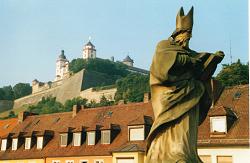
Wuerzburg
The Romantic Road starts at Wuerzburg and passes the rivers Tauber,
Woernitz and Lech until the route ends at Fuessen. Parallel
to the road of the motorized visitors there is a signed cycle path, described
in the booklet
"Vom Main zu den Alpen,
Radroute Romantische Straße"
Bielefelder Verlagsanstalt (BVA)
| |
We must start our tour in the middle of the week this time, so it will
be convenient to ride by car in the evening of Wednesday to Wuerzburg,
stay for one night there and let the car at the hotel. I find a hotel
per phone call, its name is Gruener Baum (Green Tree) and located
some hundred meters from the begin of the cycle path. We announce that
we cannot arrive earlier than 10 pm and the lady of the hotel promises
to deposit the key at a pizzeria nearby. Fortunately I do not ask how late
the pizzeria will close.
At the certain Wednesday I pick up Heidi at her shop and immediately
we start to follow the sun set. We have calculated to reach Wuerzburg in
3 hours, but with the dense traffic we need longer, moreover at Wuerzburg
we produce some detours until we find the hotel near the illuminated Fortress
Marienberg. We enter the pizzeria and get the letter for us, but we
are somewhat perplex, that the shop would have been closed ten minutes
later.
In the letter we find a description how to handle the magnetic card
as an Open Sesame. The text is:
"Put this side (arrow) in front of the red light of the entrance,
a green light will occur and the door is open. Now push this or that edge
(two
further arrows) to the red spot at the door of your room, and when the
spot turns green the door is open."
And in fact, it works!
Thursday, Wuerzburg - Waikersheim, 75 km
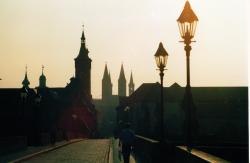
Wuerzburg Skyline
We are eager to start and deposit the key of our shabby old car at the
reception for the next 10 days. Wuerzburg for itself is worth at least
a one day inspection. But we have seen this and that on earlier visits,
so we restrict to admire the silhouette from the Old Bridge against
the morning sun. At the backside of the fortress the path slightly leads
uphill.
| |
At the first junction the route sign is missing and we choose
a steep uphill road. Heidi asks frowning "Will this continue all the time?"
My answer "We have to come out of the Main-valley, that's all". I cannot
say that I as well do not know where this road will end. But now I can
tell you: we reach the edge of a forest and then reach the village Waldbüttelbrunn.
We ask a man who sweeps in front of his house at this early morning
hour and learn the right path to Eisingen. Some time later - we
just push the bikes again - a gentleman comes along and unquestioned gives
a longish report of the historical and geographical peciularities of the
area. May be he is a retired teacher. So we are on the "Jewish Road" which
is an old merchant road. As the road turns downhill we can get rid of the
lesson.
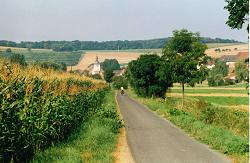
Down a valley...
But soon the next valley is to surpass, down there we hear the noise
of the Autobahn and first have a rest under a pear tree. At the opposite
slope of the valley follows a brutal uphill on gravel but fortunately through
a forest and in the shade. And that was the more strenuous first section
of the tour. From now on we follow a picturesque path down a valley, passing
sweet little villages and colourful gardens. There are a lot of former
mills like the Seemühle, Öl- and
Sägemühle, Emmenthaler Mühle, Schneidmühle or
Welzmühle.
| |
Then we reach the pilgrim's chapel Liebfrauenbrunn. There is
a spring in the cellar and the local women fill the waters into plenties
of bottles. It is so fresh and well tasting they say but we argue, that
they think of their salvation as well.
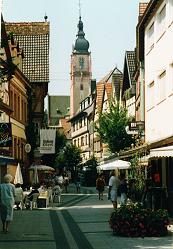
Tauberbischofsheim
Soon we reach the Tauber and then the first town Tauberbischofsheim,
where we sit on a bench at the market place for a while. Some time later
we find the first baroque church, may be that was at Lauda. And
at Bad Mergentheim we sit on another bench and listen to two local
women discussing hard about flowers and the maintanance of graves. "I would
have liked to strike the flowers into her mouth, may be she would have
preferred to change her glance" - or so in Swabian dialect, Heidi has no
chance to understand a single word.
| |
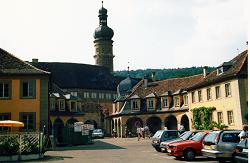
Weikersheim
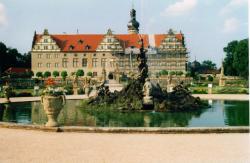
Castle in Weikersheim
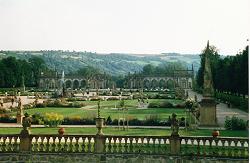
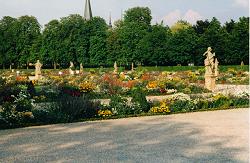
Garden of the Castle
From now on we meet many cyclists, who unfortunately occupy the most
beautiful shadowed spots for a rest. We come to Weikersheim to look
for an accomodation. At the Tourist Office they phone up the Gasthaus
Grüner Hof just opposite at the market place. We get a room though
the pub in fact is closed, but the son of the owners represents the vice-host.
Weikersheim is an attractive town as to be seen from the brochures.
It is famous as "Town of the Music-Youth" (Jeunesses Musicales Deutschland
JMD). Therefore you see plenties of youngsters rush around carrying guitar-
or violin-cases or things like that. Out of various houses the sound of
singing and tingling is to be heard. At the Lidl-Supermarket we hear a
discussion of two musicians about the techniques to twitch the chords of
a stringed instrument in an optimal way.
At our walkaround we mainly look at the menu papers which hang in front
of the pubs. But at first we visit the castle, best of it is the beautiful
garden where you can stroll around between castle, orangerie and rich flowerbeds.
For dinner we have not choosen typical local restaurant due to the Greek
Pegasos near the railway station. There is a wonderful beer-garden
where we sit under a wide treetop. After Gyros, Bifteki and some beers
eventually we ask the host what kind of tree this is. It is an elm-tree,
one of the few left in northern Bavaria. The most elms in Germany have
been killed by a desease several years ago.
| |
Friday, Weikersheim - Feuchtwangen, 72 km
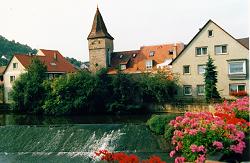
Another hot day is coming up and we start early. The path along the
Tauber is very nice. Up at the slopes of the valley there are curious stone
walls, as if they have collected the rocks over many years out of their
fields and vineyards. We find a nice place for a rest, as an older couple
with clattering vehicles comes around the corner. "You come with your helper"
we say, for they use bikes with a small motor. "Well, my wife has hurt
her knee, but so we can continue to perform cycling" the man answers. The
weight of such a bike is 36 kilo (twice as heavy as usual). Soon we are
involved in a technical discussion. They just have been in the Alps and
state, that cycling in the Alps is the best. And then they start their
motor again and - hush - disappear around the next corner, while we struggle
for the next uphill.
| |
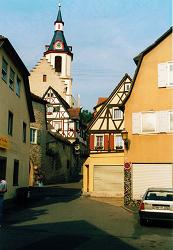
Creglingen
We come to the picture-book-town Creglingen. It's a must to make a trip
to the nearby chapel Herrgottskirche, where one can admire the world-famous
Maria Himmelfahrts-Altar of the master sculptor Tilman
Riemenschneider. It's a wonder of wooden filigree and they have spent
5 years (1505 - 1510) to complete it - as is to be read in the brochure.
Some time later we approach the greatest sensation of the whole tour:
the town of Rothenburg ob der Tauber. I give a warning to Heidi,
for the letters "ob" mean upwards of the valley. But first we meet our
motorized couple again, they have a puncture and the man just starts to
haul up the bike up a tree by a tow rope. We cannot help and cannot wait
and push the bikes up the hairpins until we arrive at one of the ancient
town gates.
| |
You feel like to enter a dolls house. If there would not be the automobiles
which nearly cannot be tolerated within such a medieval scene. Then you
realize the polyglot buzzing of the many surprised crowds of tourists strolling
around. It's hard to bear this if you just come out of the botany. We decide
not to conquer the total Rothenburg, for this would last longer than the
rest of the day. At the market place we retrieve the brochures as usual
where you can read, what you have missed. Moreover we buy some plums and
a bunch of grapes from an Italian salesman.
Meanwhile I peer around all the time. I am looking for THAT picture,
that is known by all the posters, postcards and calendar sheets. It should
be: a town gate at the left, a town gate to the right and in the middle
a half timbered front of a house. And now look down the street: there it
is, just there - and the name of the place is Plönlein.
We look for an untroubled place at this locality and this is not easy.
Heidi is successful and happily pulls me into the backyard of the Spitalhof
where we settle down at a bench around the trunk of a lime-tree. Nearby
there is the Hegereiter Haus,a seniors meeting site today. An old
barn turns out to be a "Reichsstadthalle" and a former "Zehntscheune".
Now a tourist-couple enters the scene. They are very devotional and bend
their heads back to observe the miracles - it looks like photographing
without a camera. This is the way to suck in the atmosphere, let's try
to learn from this. We put the kernels of the plums back to the paper bag
and leave. May be we return some day...
Chapter 2 Rothenburg - Fuessen
Chapter 3 Bodensee